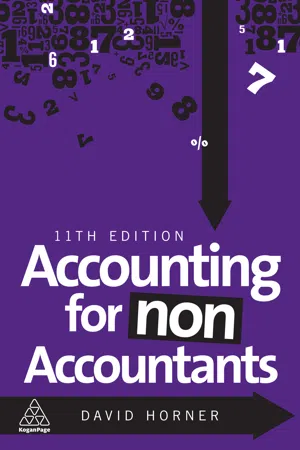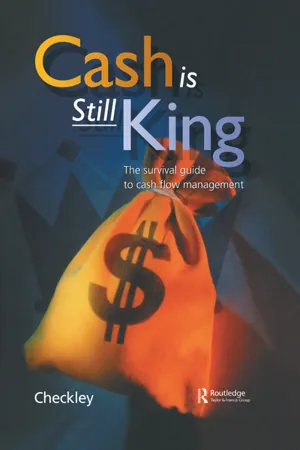Cash Conversion Cycle
The Cash Conversion Cycle (CCC) measures the time it takes for a company to convert its investments in inventory and other resources into cash flow from sales. It encompasses the period from when cash is spent on production inputs to when the cash is collected from the sale of the resulting products. A shorter CCC indicates better liquidity and efficiency in managing working capital.
7 Key excerpts on "Cash Conversion Cycle"
- Michael Chibili(Author)
- 2019(Publication Date)
- Routledge(Publisher)
...Too much cash can be detrimental to the profitability for the business. Since investors get into businesses to make profits in the form of return on investment, they expect to make more out of their investment than if they had kept the money in their own banks in the form of cash. If there is too much cash within a company, it will be advisable for management to try and invest it in such a way that it could generate returns for the company instead of staying idle in their bank accounts. The Cash Conversion Cycle (CCC) The Cash Conversion Cycle expresses the length of time that it takes for a company to convert its resource inputs into cash flows and it is expressed in number of days. It seeks to measure the amount of time the currency values of the net inputs are tied up in the production and sales process before they get converted into cash through sales to customers. It looks at the amount of time needed to sell the inventory, the amount of time needed to collect the accounts receivable, and the length of time the company is given to pay its bills by its own creditors without incurring any penalties. In some cases, the Cash Conversion Cycle is simply called the cash cycle. The Cash Conversion Cycle is determined in the following manner: Days Inventory Outstanding + Days Sales Outstanding − Days payable Outstanding Usually a company acquires inventory on credit (resulting in accounts payable), while it also sells on credit (resulting in accounts receivable). No cash is involved until the time that the company settles the accounts payable, and collects the accounts receivable. So the Cash Conversion Cycle measures the time between the disbursement of cash and the collection of cash. The shorter the cycle, the less time capital is tied up in the business process, and thus the better for the company’s profits...
- eBook - ePub
- Kalpesh Ashar, Vibrant Publishers(Authors)
- 2022(Publication Date)
- Vibrant Publishers(Publisher)
...Too much working capital leads to a reduction in profitability and too little could lead to bankruptcy. In the sections below, we see how a company calculates how much working capital it needs to set aside. 5.1 Cash Conversion Cycle The length of time a dollar is tied up in current assets is called the Cash Conversion Cycle. By calculating this length, a company gets an idea of how much working capital it needs and also how the company can improve its operations to reduce the length of this cycle. Companies buy raw materials, convert them into finished products and sell them. This is the business cycle of a typical company. Companies also get a credit period to pay for their raw materials, called Payables Deferral Period. Similarly, companies also extend credit to their customers, called DSO (this term was seen in chapter 2 earlier) or Receivables Collection Period. When we draw these on a time scale, we get the following: Figure 5.1 As seen above, the Cash Conversion Cycle is the amount of time taken from the time money is paid for the raw materials to the time money is collected from customers for the finished product. The formula below gives this relationship: Cash Conversion Cycle (CCC) = Inventory Conversion Period + DSO – Payables Deferral Period In order to reduce the required working capital, a company needs to reduce the CCC. This can be achieved either by reducing the inventory conversion period, shortening the DSO, or increasing the payables deferral period. These are the 3 levers that a company has to control the CCC...
- eBook - ePub
- Vibrant Publishers, Kalpesh Ashar(Authors)
- 2019(Publication Date)
- Vibrant Publishers(Publisher)
...This is the business cycle of a typical company. Companies also get a credit period to pay for their raw materials, called Payables Deferral Period. Similarly, companies also extend credit to their customers, called DSO (this term was seen in chapter 2 earlier) or Receivables Collection Period. When we draw these on a time scale, we get the following: As seen above, the Cash Conversion Cycle is the amount of time taken from the time money is paid for the raw materials to the time money is collected from customers for finished product. The below formula gives this relationship: Cash Conversion Cycle (CCC) = Inventory Conversion Period + DSO – Payables Deferral Period In order to reduce the required working capital, a company needs to reduce the CCC. This can be achieved either by reducing the inventory conversion period, shortening the DSO or increasing the payables deferral period. These are the 3 levers that a company has to control the CCC...
- eBook - ePub
- David Horner(Author)
- 2020(Publication Date)
- Kogan Page(Publisher)
...The firm will eventually receive the cash from these credit customers, which in turn can then be used to settle the amounts owing to the credit suppliers as well as any other obligations it has run up during this period, such as wages and other expenses. A firm will wish to minimize the length of its working capital cycle. The longer a firm holds inventories and the longer it takes to collect cash from its customers in respect of credit sales, the more likely it will face liquidity problems. Therefore a firm will want to minimize the time cash is tied up in working capital, so as to avoid potential difficulties with cash flow. The working capital cycle (also known as the firm’s operating cycle) can also be measured in terms of the time taken for money to pass through each stage of the working capital. The operating cycle for its working capital will consist of the following timings for cash being tied up in the various stages of the working capital cycle. The information used in calculating the length of the working capital cycle will be obtained from some of the accounting ratios we look at in Chapter 18. Skip table Inventory days The average amount of time inventory is held by the firm + Trade receivable days The time taken for a firm to collect its debts from its credit customers – Trade payable days The time taken by a firm to pay its debts to its credit suppliers = Working capital cycle in days For a firm that manufactures its own products the cycle will be longer than the cycle of those firms that either sell services or purchase inventory ready (or almost ready) for sale. The ideal amount of working capital to be held by a firm will depend on many factors. The size of the firm and the industry in which the firm operates will provide useful information in deciding on a prudent level of working capital...
- eBook - ePub
- David Horner(Author)
- 2017(Publication Date)
- Kogan Page(Publisher)
...After production has taken place the finished goods will be sold on to customers as either cash or credit sales (now appearing as trade receivables in the working capital). The firm will eventually receive the cash from these credit customers, which in turn can then be used to settle the amounts owing to the credit suppliers as well as any other obligations it has run up during this period, such as wages and other expenses. Figure 12.1 The working capital cycle The working capital cycle A firm will wish to minimize the length of its working capital cycle. The longer a firm holds inventories and the longer a firm takes to collect cash from its customers in respect of credit sales, the more likely a firm will face liquidity problems. Therefore a firm will want to minimize the time cash is tied up in working capital, so as to avoid potential difficulties with cash flow. The working capital cycle (also known as the firm’s operating cycle) can also be measured in terms of the time taken for money to pass through each stage of the working capital. The operating cycle for its working capital will consist of the following timings for cash being tied up in the various stages of the working capital cycle. The information used in calculating the length of the working capital cycle will be obtained from some of the accounting ratios we look at in Chapter 18. Inventory days The average amount of time inventory is held by the firm + Trade receivable days The time taken for a firm to collect its debts from its credit customers – Trade payable days The time taken by a firm to pay its debts to its credit suppliers = Working capital cycle in days For a firm that manufactures its own products the cycle will be longer than the cycle of those firms that either sell services or purchase inventory ready (or almost ready) for sale. Example 12.1 Consider the following two businesses – one located in the construction industry and another in the supermarket sector...
- eBook - ePub
- Keith Checkley(Author)
- 2012(Publication Date)
- Routledge(Publisher)
...Metrics included days sales outstanding (DSO), days in inventory (DSI), days payables outstanding (DPO). Add DSO and DSI, then subtract DPO, and you get the chief metric Dell uses to measure its liquidity: Cash Conversion Cycle (CCC). The metrics tell a compelling tale. Dell’s Cash Conversion Cycle has gone from an acceptable 40 days to a phenomenal minus 5 days in the fourth quarter of 1997. “Our biggest improvement was in the inventory area, which we drove down from 30-plus days to 13 days”, Caswell says. “We analysed key inventory drivers to identify who was holding inventory and where. It turned out to be us almost exclusively. Shorter Receivables, Longer Payables Improved inventory cycles were just part of the CCC turnaround. DSO was pared from an already-respectable 42 days to 37 days over the one-year period. What did the trick? It was new collections tools provided to Dell’s customer financial services department to improve order processing and collection activities. Dell also was able to make similar headway in the DPO metric, which increased from 33 days to 54 days...
- eBook - ePub
- Clive Marsh(Author)
- 2013(Publication Date)
- Kogan Page(Publisher)
...CHAPTER TWELVE MANAGING AND MODELLING CASH FLOW AND WORKING CAPITAL A ccrual accounting is a wonderful thing. It makes perfect logical sense. It is the internationally accepted standard and few accountants would propose any form of cash accounting to replace it. However, let’s not lose sight of the importance of cash. The saying, which I know you would have heard, ‘sales are vanity, profit is sanity, but cash is king’, holds true. Cash is the lifeblood of any organization. Many profitable companies have folded through a lack of cash. Overtrading is a common danger and banks can be very fair-weather friends. In this chapter we will explore cash and cash modelling. The cash flow cycle Most companies purchase some material, do something with it, pay their staff, add a margin, sell a finished product and then collect some cash. The problem is funding the period between making an initial purchase of material and collecting cash from a customer. Funds may be provided by an investor/proprietor/shareholder or by a lender such as a bank. The more money borrowed from a bank the higher a company will be geared. Ensuring that there is enough cash in the bank to fund operations is a key to business survival and this requires careful financial modelling. The cash flow cycle is the time it takes for a company to convert initial purchases of raw materials into cash received from customers. For example, the number of days funding for a manufacturing company could look like this: Purchase of raw materials – cash on delivery Day 1 Time in warehouse – buffer stock 15 days Manufacturing and W.I.P. time 5 days Time in finished warehouse 10 days Sales order and trade credit taken 60 days Total funding period 91 days Funding for this period plus some contingency needs to be built into the cash budget so that a company can continue to trade and meet its obligations. Cash may be considered as a part of working capital...






